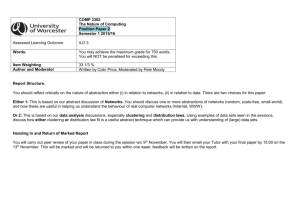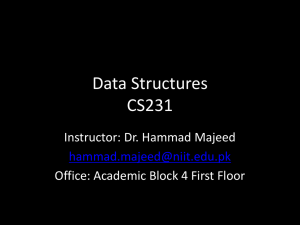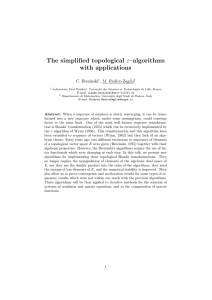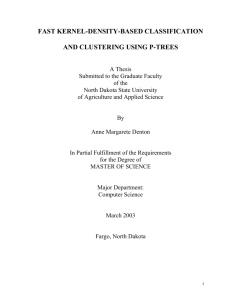Document Clustering for Forensic Analysis An Approach for
advertisement
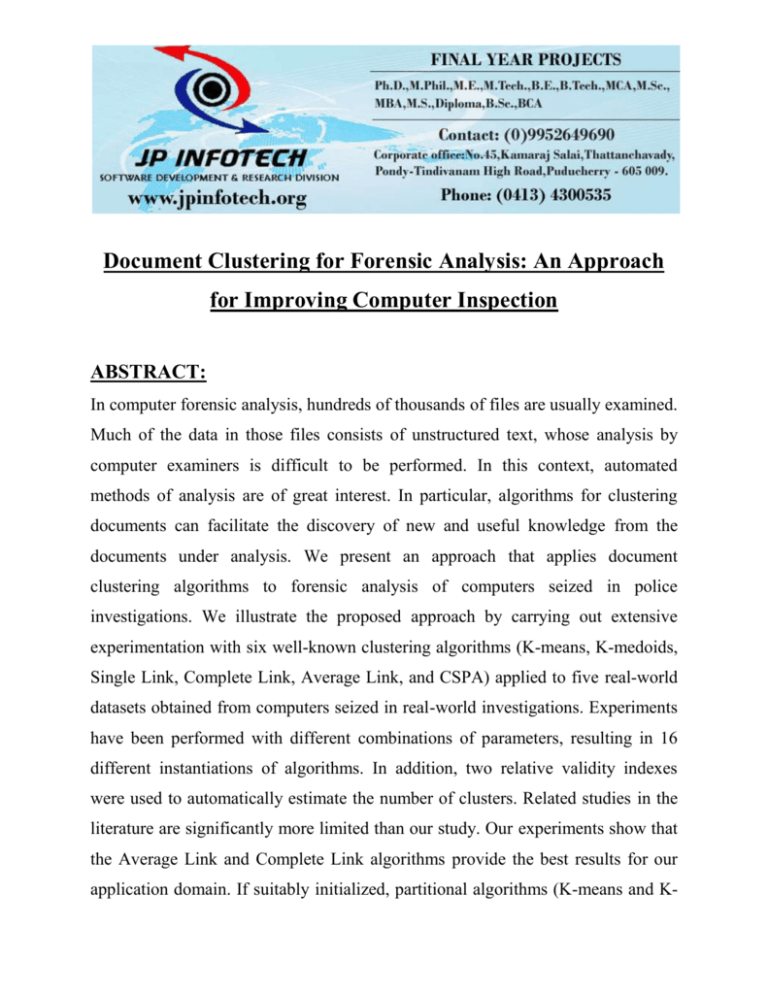
Document Clustering for Forensic Analysis: An Approach for Improving Computer Inspection ABSTRACT: In computer forensic analysis, hundreds of thousands of files are usually examined. Much of the data in those files consists of unstructured text, whose analysis by computer examiners is difficult to be performed. In this context, automated methods of analysis are of great interest. In particular, algorithms for clustering documents can facilitate the discovery of new and useful knowledge from the documents under analysis. We present an approach that applies document clustering algorithms to forensic analysis of computers seized in police investigations. We illustrate the proposed approach by carrying out extensive experimentation with six well-known clustering algorithms (K-means, K-medoids, Single Link, Complete Link, Average Link, and CSPA) applied to five real-world datasets obtained from computers seized in real-world investigations. Experiments have been performed with different combinations of parameters, resulting in 16 different instantiations of algorithms. In addition, two relative validity indexes were used to automatically estimate the number of clusters. Related studies in the literature are significantly more limited than our study. Our experiments show that the Average Link and Complete Link algorithms provide the best results for our application domain. If suitably initialized, partitional algorithms (K-means and K- medoids) can also yield to very good results. Finally, we also present and discuss several practical results that can be useful for researchers and practitioners of forensic computing. EXISTING SYSTEM: Clustering algorithms are typically used for exploratory data analysis, where there is little or no prior knowledge about the data. This is precisely the case in several applications of Computer Forensics, including the one addressed in our work. From a more technical viewpoint, our datasets consist of unlabeled objects—the classes or categories of documents that can be found are a priori unknown. Moreover, even assuming that labeled datasets could be available from previous analyses, there is almost no hope that the same classes (possibly learned earlier by a classifier in a supervised learning setting) would be still valid for the upcoming data, obtained from other computers and associated to different investigation processes. More precisely, it is likely that the new data sample would come from a different population. In this context, the use of clustering algorithms, which are capable of finding latent patterns from text documents found in seized computers, can enhance the analysis performed by the expert examiner. The rationale behind clustering algorithms is that objects within a valid cluster are more similar to each other than they are to objects belonging to a different cluster. Thus, once a data partition has been induced from data, the expert examiner might initially focus on reviewing representative documents from the obtained set of clusters. Then, after this preliminary analysis, (s) he may eventually decide to scrutinize other documents from each cluster. By doing so, one can avoid the hard task of examining all the documents (individually) but, even if so desired, it still could be done. DISADVANTAGES OF EXISTING SYSTEM: The literature on Computer Forensics only reports the use of algorithms that assume that the number of clusters is known and fixed a priori by the user. Aimed at relaxing this assumption, which is often unrealistic in practical applications, a common approach in other domains involves estimating the number of clusters from data. PROPOSED SYSTEM: Clustering algorithms have been studied for decades, and the literature on the subject is huge. Therefore, we decided to choose a set of (six) representative algorithm in order to show the potential of the proposed approach, namely: the partitional K-means and K-medoids, the hierarchical Single/Complete/Average Link, and the cluster ensemble algorithm known as CSPA. These algorithms were run with different combinations of their parameters, resulting in sixteen different algorithmic instantiations. Thus, as a contribution of our work, we compare their relative performances on the studied application domain—using five real-world investigation cases conducted by the Brazilian Federal Police Department. In order to make the comparative analysis of the algorithms more realistic, two relative validity indexes have been used to estimate the number of clusters automatically from data. ADVANTAGES OF PROPOSED SYSTEM: Most importantly, we observed that clustering algorithms indeed tend to induce clusters formed by either relevant or irrelevant documents, thus contributing to enhance the expert examiner’s job. Furthermore, our evaluation of the proposed approach in applications show that it has the potential to speed up the computer inspection process. SYSTEM CONFIGURATION:HARDWARE CONFIGURATION: Processor - Pentium –IV Speed - 1.1 Ghz RAM - 256 MB(min) Hard Disk - 20 GB Key Board - Standard Windows Keyboard Mouse - Two or Three Button Mouse Monitor - SVGA SOFTWARE CONFIGURATION: Operating System : Windows XP Programming Language : JAVA Java Version : JDK 1.6 & above. REFERENCE: Luís Filipe da Cruz Nassif and Eduardo Raul Hruschka “Document Clustering for Forensic Analysis: An Approach for Improving Computer Inspection” - IEEE TRANSACTIONS ON INFORMATION FORENSICS AND SECURITY, VOL. 8, NO. 1, JANUARY 2013.

